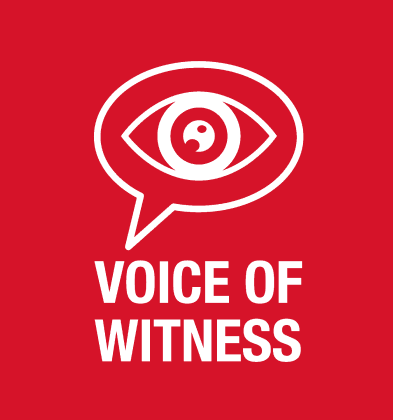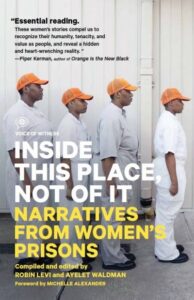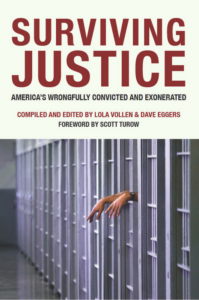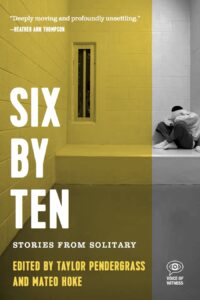The Voice of Witness book series amplifies the stories of people directly impacted by—and fighting against—injustice. We use an oral history methodology that combines ethics-driven practices, journalistic integrity, and an engaging, literary approach.
The books explore issues of inequity and human rights through the lens of personal narrative. Each project aims to disrupt harmful narratives by supporting historically marginalized or silenced communities to tell their own stories in their own words.
Book clubs are useful tools for engaging and interacting with these oral histories and the issues they highlight. Find our handout with guidance on planning and facilitating one here.
Use the questions below to start a book club for Inside This Place, Not of It: Narratives From Women’s Prisons.
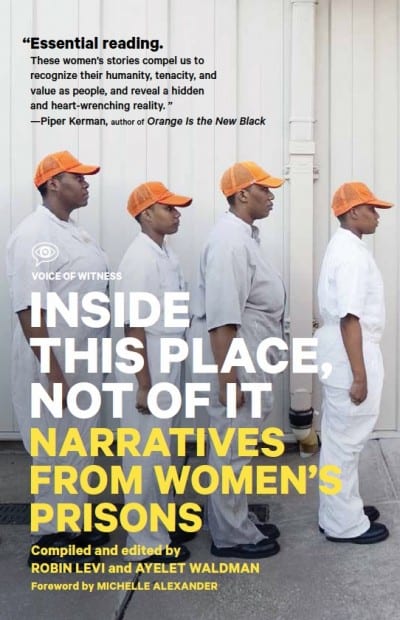
Discussion Questions:
- In her foreword to the book, Michelle Alexander writes that “our women’s prisons are filled with people from the poorest, most vulnerable and marginalized segments of our society, whose offenses are often a consequence of their circumstances: lack of access to employment, familial stability, drug treatment, and protection from sexual and physical abuse.” Examine Alexander’s point—how might circumstances such as the ones Alexander outlines lead to imprisonment? What, if anything, can be done about it?
- Olivia Hamilton, who was incarcerated for a relatively minor theft charge, gave birth while in prison. Prison doctors gave her a medically unnecessary Cesarean section, keeping her shackled during the operation. Olivia was then sent back to the prison, leaving her newborn baby at the hospital. Think about the long-term effects of this type of trauma on Olivia, her baby, and her family. What do you think prisons should do with women who have babies while incarcerated?
- Several of the narrators in the book were raped or sexually assaulted by prison guards. Given the power dynamic and the fact that institutions are more likely to believe their employees than inmates, what should be done in prisons to prevent this from happening? How should these acts be brought to light?
- After her release from prison, Emily Madison gets a job at a club, which pays her well enough to support herself and her daughter and pay all the bills. When her probation officer finds out she is working at a club, she tells Emily that the conditions of her probation prohibit her from working anywhere that sells alcohol. What other barriers to successful reentry can you think of? What happens to people who cannot get hired or find a place to live after they are released? What options exist?
- Anna Jacobs describes her addiction and how it led to her incarceration. According to the Bureau of Prisons, almost half of the people in federal prisons are incarcerated for a drug offense, and 16% of people in state prisons have a drug charge as their most serious offense (a much larger percentage were under the influence of drugs or alcohol during the commission of their crime). Are there better alternatives than prison for people living with addiction? If so, what are they?
- In almost every narrative in the book, we learn of the severe childhood trauma that the narrators endured: physical and sexual abuse, neglect, family violence, and poverty. How might these adverse childhood experiences lead to crime? What, if anything, could be done to interrupt this cycle of trauma?
- Victoria Sanchez’s son, Ethan, who was just an infant when his mother was arrested, is now an activist. He goes to the state capitol to speak to legislators about juvenile incarceration. Think about the scope of the impact Ethan could have. How might Ethan’s activism in turn affect Victoria’s life and experience?
- Transgender inmates are especially vulnerable in prisons. They are often harassed, misgendered, denied medication, and assaulted by guards and other inmates. Charlie Morningstar describes initially being sent to a women’s jail, where his case was “sensationalized” in the news because of his gender identity. What laws and systems should be in place to protect transgender people who get arrested? Are there other recent examples you can think of? If so, how do they compare/contrast with Charlie’s story?
- Irma Rodriguez was diagnosed with HIV while she was in prison. Her diagnosis triggered depression, suicide attempts, and anxiety. Irma took combinations of antiviral therapy for almost ten years, enduring extreme side effects. A later test revealed that she never had HIV. Irma suspects that the prison had a relationship with a corrupt lab, and that the prison was getting kickbacks for medication purchases. What does Irma’s story reveal about the trauma that people endure while in prison beyond just their incarceration?
- As the editors say in their introduction to the book, 80% of women in U.S. prisons are the primary caretakers of children. Does society have a moral obligation to take care of children of incarcerated parents? If so, how? Brainstorm several examples.
